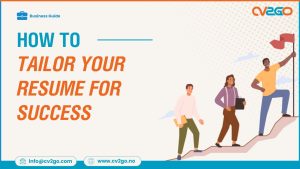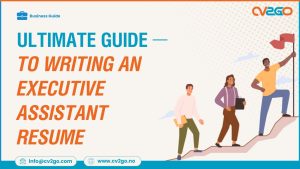You may have heard that the shorter your resume, the better. In the US, the one-page resume has long been the gold standard. However, the two-page resume is gaining popularity, and some believe it may even offer candidates an advantage.
Read on as we answer the question: Is a two-page resume okay? And if so, what’s the best way to structure it for maximum impact and readability?
Crafting Your Resume: One Page or Two?
On average, recruiters spend just 7.4 seconds looking at a resume. In that context, a one-page resume makes sense. By cutting out all the fluff, you ensure a recruiter’s attention is directed to the most essential information. When a resume fits onto a single page, it’s much easier for the recruiter to get a quick overview of who you are within those crucial few seconds.
Yet it’s not always that simple. A 2018 study found that employers were 2.3 times as likely to hire a candidate with a two-page resume. They also spent significantly more time reviewing the longer resumes, which suggests they appreciate the additional detail when it’s relevant.
Which Length is Right for You?
- One-Page Resume: Best for candidates with limited relevant experience, such as recent graduates or those changing careers.
- Two-Page Resume: Ideal for those with extensive experience, multiple achievements, or specialized skills that need elaboration.
If you find yourself cramming everything onto one page with tiny fonts or squeezing in extra columns, it’s better to extend your resume to two pages. A hybrid resume structure — combining skills with chronological work history — can also lend itself well to a two-page format.
However, unless you’re applying for academic or senior executive roles in the US, your resume should not exceed two pages. If you’re applying for jobs internationally, remember to check local customs:
- UK: Resumes (CVs) are typically two pages long.
- Singapore: Resumes can be as long as three to four pages.
In summary, your resume should be as long as necessary to effectively demonstrate why you’re the ideal candidate, but no longer than two pages. Prioritize relevance and clarity to make every word count.
Tips for Building a Two-Page Resume
When writing a two-page resume, there are additional considerations to ensure it remains effective and easy to read. Here are some key tips to make the most of the extra space:
1. Mind the Page Break
- Ensure the page break doesn’t split a job description or key section in half.
- Aim to place your most critical roles and achievements on the first page to grab attention immediately.
- Consider using a manual page break to control the formatting precisely and avoid awkward splits between sections.
2. Add Detailed Achievements
- Use the extra space to elaborate on metrics, accomplishments, and responsibilities relevant to the role.
- Focus on quantifiable achievements, such as “Increased sales by 20% within six months” or “Streamlined processes, reducing project completion time by 15%.”
- Avoid adding filler content. Every detail should provide value and demonstrate your qualifications.
3. Maintain White Space
- White space is crucial for readability and overall presentation.
- Use reasonable margins, adequate line breaks, and bullet points to prevent the resume from looking cluttered.
- Plenty of white space helps the reader’s eyes navigate the content more smoothly, making your resume more inviting.
4. Consistent Formatting
- Stick with traditional fonts like Arial, Times New Roman, or Calibri in 12-point size for body text.
- Use bold headers and sub-headers to structure your resume clearly.
- Ensure consistency in formatting, such as bullet point styles, font sizes, and line spacing throughout the document.
Structure for a Two-Page Resume
Here’s a detailed structure you can adapt for a two-page resume:
1. Your Name and Contact Details
At the top of the first page, include:
- Full Name
- Phone Number
- Professional Email Address
Optional additions:
- Portfolio Links (for roles in design, writing, or development)
- LinkedIn Profile
Avoid including personal details like a photo, marital status, or full address unless specifically requested.
2. Objective Summary
Write a 2-5 sentence summary that gives a snapshot of your background, core skills, and career goals. If a recruiter reads only this section, they should still understand your professional profile.
3. Skills
List your most relevant skills using bullet points. Provide evidence for each skill where possible. For example:
- Fluent in Spanish and French: Achieved C1 (Advanced) DELE and TFI certifications.
- Sales Skills: Named Top Salesperson of the Month three times in 14 months.
4. Professional Background or Education
Based on relevance, decide whether to list your work experience or education first:
- Work Experience: List jobs in reverse chronological order with bullet points for key achievements.
- Education: Include degrees, certifications, and notable coursework or honors.
5. Education or Professional Background
Whichever section you didn’t include earlier should go here.
6. Additional Sections
Include any extra details such as:
- Certifications
- Professional Associations
- Languages
- Volunteer Experience
Resume Templates to Help You Stand Out
Recruiters often receive dozens or hundreds of applications for a single role. Your resume needs to be:
- Eye-Catching: Use a clean, professional design.
- Well-Structured: Organize sections logically for easy scanning.
- Machine-Readable: Ensure it’s ATS-friendly.
- Tailored: Customize content to align with the job description.
Simplify the Process with CV2Go
At CV2Go, we offer:
- Millions of Templates: Professionally designed and customizable for any role.
- Resume Builder: Provides structure, phrasing, and layout suggestions tailored to your experience.
- ATS Optimization: Ensures your resume passes applicant tracking systems.
Whether you choose a one-page or two-page format, our tools make it simple to highlight your strengths effectively.
Build Your Resume in 10 Minutes
Don’t leave your next job opportunity to chance. Use CV2Go to create a resume that recruiters will love.
Get started now and take the next step in your career!




